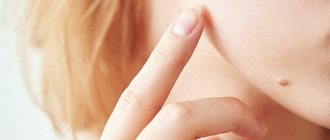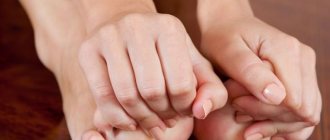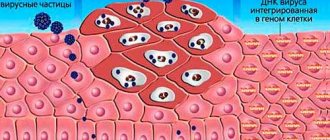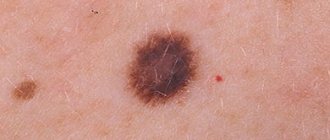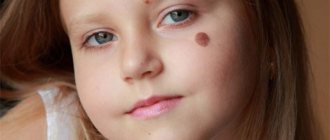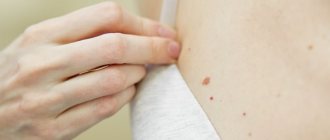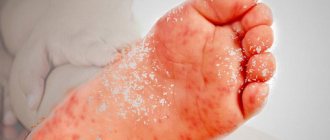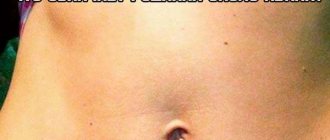Home / Articles / Why does the skin around a mole itch?
Moles and age spots should not cause discomfort or discomfort to a person. If at least one nevus begins to hurt or itch, becomes red or swollen, you need to make an appointment with a dermatologist. Sometimes it is enough for a specialist to examine the patient to determine why the skin around the mole and the mole itself are itching. In some cases, only examination of the tumor tissue helps to find the cause of the discomfort. Find out what causes itching nevi exist and why this symptom is dangerous.
Causeless itching
Probably each of us periodically feels the desire to scratch one or another area of the skin. This can happen up to several times a day, for no apparent reason. For example, a person simply scratched his nose, but after that, no thoughts about possible diseases of the nasal cavity (sinusitis, rhinitis) arise. By the way, according to research, a person’s nose itches more often when he knows that he is not telling the truth.
The same can happen with a mole - it is not the mole itself that itches, but the area of skin around or next to it.
What are moles and why do they appear?
Moles are pigmented skin formations consisting of cells containing large amounts of melanin. Their formation is facilitated by impaired synthesis of this natural pigment. This is why people are rarely born with moles, but become their owners as they grow older.
In medicine, moles are called nevi and are divided into congenital and acquired.
The congenital form is observed in some children immediately after birth. As a rule, such moles are located in the same place as one of the parents and have a similar shape. Due to underdeveloped pigmentation in newborns, they can be poorly expressed and barely noticeable.
Acquired nevi appear in people throughout life, as a result of:
- Hormonal fluctuations
- Traumatic effects on the skin
- Excessive ultraviolet radiation (prolonged exposure to the sun, abuse of solarium)
- Viral diseases
- Radiation Exposure
- Hereditary predisposition
Basically, moles are considered a cosmetic defect. Their number, shape and size are not of great importance as long as they do not bother their owner. However, you should be aware of the existing danger: at a certain point, a mole may begin to change and ultimately degenerate into a malignant formation.
It is very important to constantly examine your own moles and, if you notice signs of changes, immediately consult a doctor. Closer attention should be paid to convex moles, as well as large nevi (more than five millimeters) and located in places where they can be easily injured: on the back, neck, armpits, etc.
Psychological itch
Repeatedly I listened to the following story from the lips of different patients:
“A mole itched. I went online with the request “mole itches.” I’ve read horror stories from unknown authors, who all write that this is a sign of degeneration into melanoma. The mole began to itch 2 times more intensely and 3 times more often, until the skin around it turned red. I didn’t sleep at night, I didn’t eat for a day, I barely made it to you for a consultation, tell me, am I going to die?”
If you smiled now and recognized yourself in this story, try not reading the Internet on the topic of melanoma and skin cancer for 3 days and perhaps the mole will itch less.
Why a mole on the body itches: finding out the reasons
First, let's figure out why a mole itches and what dangers this may indicate.
If a birthmark, in the area of which there is no itching or burning, has not changed its shape or color, then there is nothing particularly dangerous about it. Most often, nevi form on the neck, back and arms, legs, head, and groin area, so it is not surprising that they can rub and, accordingly, become inflamed.
Trauma to birthmarks as a cause of itching
The reasons why a mole itches is often associated with mechanical damage to its cells. This may happen:
- while shaving,
- when scratching the skin in the area where the nevus is located,
- as a result of friction against clothing or any other hard surface,
- when combing hair,
- during cooking, etc.
As you can see, there are quite a few traumatic reasons why moles on the body itch. It’s easy to understand them; you just need to remember exactly what actions preceded the appearance of itching in the area of the nevus. If none of the above could provoke this anomaly, you, for your own safety, need to contact a dermatologist or oncologist.
Briefly about the main thing:
Itching alone is EXTREMELY rarely a sign that a mole has turned into melanoma. Most often it is caused by other reasons. In addition, the malignancy of the mole should be accompanied by symptoms other than the feeling that the mole itches
.
If you still have questions, the following will help you:
- In-person appointment with an oncologist
(St. Petersburg) - Mole removal
with histology (St. Petersburg) - My online consultation (from anywhere in the world)
What to do if the nevus itches?
What to do if a mole itches? It all depends on what process is causing it. If the anomaly is associated with inflammation, you can treat the birthmark with ichthyol or erythromycin ointment.
Compresses made from decoctions of medicinal plants, which have antiseptic, anti-inflammatory and soothing effects, help well:
- daisies,
- calendula,
- sage,
- St. John's wort,
- celandine.
You can purchase an ointment based on calendula extract and treat painful nevi with it. But such therapy is carried out only on the condition that the reasons why a mole on the neck, back, arm or other part of the body itches is not related to the process of its degeneration into melanoma.
Treatment with antiseptic solutions should be carried out regularly, regardless of whether any ointments or herbal decoctions are used or not. The drugs Furacilin (not an alcoholic solution, but an aqueous solution!) and Chlorhexidine help relieve inflammation and redness of the epidermis.
Important! If a mole itches and hurts, you should never lubricate it with alcohol! In the absence of antiseptic agents, you can treat the growth with vegetable oil, which will protect it from infection and slightly moisturize dry and flaky skin.
How is melanoma treated?
If moles on the body itch due to their malignancy, medical intervention is necessary! It is the nevi that degenerate into melanoma, which is treated through surgery.
Actions in case of itching
Not all people know what to do if moles or one of them itch. And because of this they go to extremes. Some “close their eyes” to unpleasant sensations, trying not to notice them; while the latter panic and, with thoughts of imminent death, rush to the doctor. Of course, consulting a specialist is a good thing and never hurts. But there are not always reasons for strong feelings.
If the itchy mole has not changed color, shape, size; does not hurt, does not bleed, does not become inflamed; appeared in childhood and is constantly in contact with clothing, perhaps it’s all a matter of friction. You need to adjust your wardrobe, ensuring sufficient distance between the nevus and the fabric. Most likely, the mole will soon stop itching. In this case, applying a sterile bandage soaked in a weak solution of vinegar also helps. If it continues to itch, you will have to go to the doctor to find out the cause.
Consultation with a specialist is especially important when itching is accompanied by other disturbing phenomena described above. There is no point in delaying a visit to the doctor, and the mole should be protected as much as possible from damage. For example, cover it with a band-aid. The thing is that if a malignant transformation has begun, even the slightest injury to the nevus can significantly speed up the process. That is why it is strongly recommended not to arbitrarily remove moles that cause concern. Before going to a beauty salon, you should definitely get the doctor’s approval.
To protect yourself from the worst, you need to monitor your moles throughout your life. Normal nevi have a smooth (but not shiny) surface, even color and the same edges (not jagged or wavy); their diameter does not exceed five millimeters; they are symmetrical. If just such a mole itches, most likely the cause is easily removable. But for greater peace of mind, it is better to visit a dermatologist.
What to do if a mole turns red and inflamed
Most birthmarks, or nevi, are benign in origin and do not cause any trouble or discomfort to their owner. In some cases, you need to pay special attention to the pigmented spot if it begins to change, as this may indicate pathological processes occurring in the body. If a mole turns red, then this is one of those cases when it is necessary to find out the reason in order to protect yourself from unpleasant consequences and understand what to do next.
Why did the redness occur?
A mole is a consequence of a malfunction of melanocytes - cells that produce the pigment melanin, the accumulation of which forms a nevus. It can be congenital or acquired, but in any case, with the normal development of the neoplasm, it should not change throughout a person’s life. In some cases, when certain types of growths appear, a change in shape or size is acceptable if it occurs slowly and consistently, but a change in color should always be alarming. If a mole becomes itchy, red, swollen, inflamed, or enlarged, this may be due to the following reasons.
First, there may be mechanical damage. There can be more than a hundred moles on the human body, and most of them do not pose a danger, since they are small in size, flat in shape and located in places that are not subject to aggressive influence. However, there are also nevi that are located in those areas of the body that a person constantly touches during regular procedures; these can be neoplasms on the neck, scalp, armpits, etc. Moles react painfully to any aggressive influences, and even if you have already forgotten about the damage, the growth may turn red after a while.
Secondly, chemical damage may have occurred. In addition to physical effects, nevi are also negatively affected by chemicals. This could be low-quality cosmetics with an abundance of harmful synthetic substances, hygiene products with aggressive composition, household chemicals, etc.
Thirdly, ultraviolet radiation could have a negative effect. Despite the fact that tanning makes the skin beautiful, it can also negatively affect human health. Due to systematic sunburn, new moles may appear and old ones may change, so it is not recommended to stay on the beach or in the solarium for too long without the protection of special products.
Fourthly, self-removal of a mole or the hair that grew from it could provoke redness. Doctors do not recommend trying to remove a nevus on your own using pharmaceutical drugs or traditional medicine. You will not be able to do this properly, since only the superficial manifestation of the neoplasm will be removed, and its base will still remain in the deep layers of the skin. It is also not recommended to pull out hairs from a mole, since in this case it will be damaged, and you will not be surprised if it becomes inflamed, red or itchy.
Fifthly, hormonal changes may manifest themselves in this way. In some cases, a change in the shade of a mole may indicate an imbalance of hormones in the body. This can happen during puberty, pregnancy, or menopause in women. If your case does not fit those listed, you may have a hormonal disease, for which you need to see a doctor as soon as possible.
Finally, the reason that a mole is inflamed, red or itchy may be degeneration into melanoma. This is the most dangerous reason for a change in the shade of a nevus; the advanced process of malignancy, that is, the transformation of a benign neoplasm into a malignant one (melanoma) can lead to death. In this case, you must definitely go to the oncology hospital for tests and consultation with a surgeon.
The nevus itches and turns red
If a mole turns red and itches at the same time, this is a more serious reason to go to the hospital, if single symptoms do not cause you to worry. A competent specialist will conduct the necessary tests and tell you what needs to be done next. This situation cannot be neglected, since such manifestations may indicate the appearance of melanoma.
It happens that a mole itches due to damage, for example, a scratch or cut while shaving. This means that the wound was infected, and the redness of the nevus only confirms this assumption. Many people notice that after itching and redness, inflammation and pain begin in the area of the tumor. If the reason lies only in injury to the mole, the doctor prescribes anti-inflammatory drugs, and the problem can be quickly eliminated.
Some people notice that the mole itches during pregnancy; in this case, you can only relieve the itching with medications prescribed by your doctor.
When a nevus itches a lot, you should not be tempted; you can only lightly move your fingertip over this area of skin to slightly reduce the itching. As a last resort, you can make a compress; to do this, you need to moisten cotton wool or a bandage in a weak solution of water and table vinegar and apply the compress to the tumor for a few minutes.
The nevus is red and painful
If the mole is red and painful, you need to remember whether you have damaged it recently - with a comb if the nevus is localized on the scalp, with clothing if it is located on the neck, with a razor if it is in the armpits or groin. Usually, painful sensations arise precisely because of aggressive influence, and after some time they pass without any intervention. To prevent infection, you can treat the damaged tumor with hydrogen peroxide, and walk along its edge with brilliant green or iodine.
If the pain does not go away for a long time, and at the same time the mole becomes inflamed and turns red, you need to consult a doctor to get a diagnosis. In most cases, prolonged changes occurring with the nevus indicate its malignancy, so it is undesirable to hesitate.
Treatment tactics
When you go to the hospital, the doctor will conduct a visual examination of the neoplasm, ask you about the time the mole appeared, the features of its development and the details of the changes. If a diagnosis is not made during the initial examination, hardware diagnostic methods will be prescribed - dermatoscopy and siascopy. These tests allow you to examine the tumor without damaging it, and the results are usually quite accurate. If the diagnosis is not made even after this, the doctor may advise doing a biopsy - taking material for subsequent research.
In case of melanoma formation, specialists prescribe traditional surgery using a scalpel. It allows you to remove a malignant tumor with a high probability of no complications or relapses. The operation is characterized by a long recovery period and the presence of scars in most cases. If the nevus does not pose a danger, it can still be removed as a preventative measure; this can be done using both traditional excision and hardware procedures. These include:
- laser therapy;
- cryodestruction (exposure to liquid nitrogen);
- electrocoagulation;
- radio wave therapy (radio knife).
BezPapillom.ru>
Good and bad moles
Many people worry about having a lot of moles on their body. They wonder how dangerous it could be and what it even means. But experts say that a large number of moles cannot be described as “good” or “bad.” Also, the number of moles can be inherited. And people who like to lie in the sun expose their skin to the formation of age spots or moles. Most moles on our body are acquired.
Oncologists stipulate that the appearance or damage of a flat mole is not the worst thing. It is not necessary to contact specialists right away. Treat a damaged mole, rejoice at a new one. But if a large convex mole bleeds, hurts or is damaged, run to the doctor. It is more acute inflammatory in nature. And it is not the most pleasant formation on your body. Which most people get rid of.
Also, after injury to a birthmark, you should limit yourself from exposure to ultraviolet radiation. It has a very negative effect on our skin, and even more so on the injured area.
It is worth paying attention to the color of the mole; the darker it is, the greater the danger. If you have a flat mole, it should always remain that way. As soon as a lumpiness or increase in size appears on it, a doctor is needed.
Symptoms accompanying nevus malignancy
Malignant degeneration of a mole is called malignancy, and the disease itself is called melanoma. This is a very insidious and serious disease that often leads to the death of a person. Especially if you do not recognize it and start treatment at the initial stage. The insidiousness of melanoma lies in the fact that in the early stages it often does not manifest itself at all, or the symptoms are practically not expressed and do not attract the attention of the patient. And when the signs make themselves felt, the situation is already so advanced that it is difficult to improve the situation.
If manifestations of melanoma are still present, then the nevus does not only itch. There are other symptoms, namely:
- the mole is growing, its size exceeds 5 millimeters;
- the outlines of the nevus become blurred;
- cracks, crusts, and ulcers appear on the surface of the birthmark;
- nevus and the skin around it peels off;
- pain or tingling occurs in the area of the mole, it looks inflamed;
- the surface of the mole “goes bald”: if there were hairs before, they fall out;
- the nevus changes color (becomes red, orange or dark blue);
- there is redness around the mole;
- the nevus is bleeding.
Why does the mole bleed/hurt/swell/swell?
There are many reasons for bleeding from moles. Because every tear in a birthmark is a consequence of a domestic injury. If you are a person who has a fair amount of raised growths, you should be careful. In everyday life, the reasons may lie in simple actions, for example:
- The woman's underwear caught or pressed tightly against the mole.
- Rubbing due to the compressed belt, collar on your skin.
- Children love to explore themselves. When a baby sees a mole, he or she may start picking at it. The result is bleeding and a broken spot.
- They were injured by a razor, a knife, scissors, a machine.
- Injury while working with construction materials.
Has the reason been found out? A mole, like our skin, when it is traumatized will spew blood, hurt, pinch and swell. Remember when you fell on your knee - you started bleeding and the clogged area hurt. Moles react the same way.
If the injury is in the nature of mechanical damage, there is nothing to be afraid of. It will be enough to treat the wound and seal it with a band-aid. This way, a crust can form and return the mole to its place. But do not delay seeing a doctor if it does not heal for a long time and hurts for a long time. These may be symptoms of serious illnesses.
Is it dangerous if a mole hurts?
Painful sensations in the area where the mole is located are sometimes a symptom of the degeneration of this neoplasm.
What to do when pain appears and what are the reasons for its development?
Each person on average has about 25 moles, localized in different areas of the skin or mucous membranes.
Normally, these neoplasms do not cause their owners any discomfort, but in some cases pain may appear in the area of the nevus.
Why does a mole hurt, what to do in this case and how to avoid such situations?
Why do they appear?
There are several reasons for the appearance of nevi.
The formation of congenital moles can be caused by:
- genetically hereditary birthmarks,
- belonging to a certain race - Mongolian spot;
- congenital pathology of skin development - giant pigmented nevus.
Photo: giant pigmented nevus
Acquired benign skin tumors are formed as a result of excessive accumulation of melanocytes in a certain area, which can be caused by:
- exposure to sunlight;
- radioactive exposure;
- chemical, thermal or mechanical trauma to the upper layers of the skin;
- changes in hormonal levels as a result of illness, pregnancy or menopause;
- chronic diseases of the endocrine system;
- microtraumas over a long period of time.
A benign tumor that develops as a result of pathological changes in blood vessels (hemangioma) is also considered by many to be a mole.
Causes of pain
Photo: mole injury
The main causes of painful sensations at the location of the mole and surrounding tissues are:
- injury to the neoplasm. A nevus can be damaged by clothing, jewelry, during work or during hygiene procedures. Also, procedures performed in beauty salons can cause injury to a mole. Hair styling and cutting, manicure and pedicure, depilation and other manipulations designed to help you become beautiful can lead to the development of a malignant skin tumor. Most often, moles on the neck, head and in the bend of the limbs are injured;
- increase in the size of the mole. Too rapid a nevus growth rate can also cause pain and should alert the patient;
- prolonged exposure to a solarium or under the open sun causes the development of a sunburn, which can cause pain. But if this pain does not go away within a week and is localized only in the area of the tumor, you should consult a doctor;
- inflammation of a mole on the body or face, caused by various external or internal causes, is also the cause of pain;
- malignancy or malignant degeneration of a neoplasm - very often pain can be the first symptom of the development of this terrible disease.
Dangerous symptoms
The inflammatory process that occurs in the area where the birthmark is located can cause it to degenerate into a malignant neoplasm.
Symptoms that a mole is inflamed may include redness of the skin around it, soreness, the development of swelling and local hyperthermia (increased temperature of the skin).
Photo: degeneration of nevus into melanoma
If such manifestations occur, you should consult a doctor and not self-medicate.
However, not every inflammation is a sign of degeneration of a nevus into melanoma.
You should urgently visit a specialist if:
- the symmetry of the neoplasm is disturbed - in this case, it happens that one half of it becomes lumpy, changes color (reddened or blackened), and increases in size;
- the outlines of the birthmark change, its edge becomes uneven, torn or blurred;
- the mole changes its color - it can become dark or, on the contrary, lighten, sometimes its surface becomes as if spotted. In this case, it is worth paying attention not only to the change in the color of the nevus itself, but also the shade of the tissues surrounding it;
- the size of the mole changes, it grows quickly;
- grooves or bumps appear on the surface of the neoplasm;
- the mole is bleeding or crusted over;
- the tumor is swollen and hurts when pressed.
Video: “Dangerous moles! Is it worth removing and how to recognize melanoma in time?”
What to do if a mole hurts
With such symptoms, you should consult a doctor in order to determine why the pain appeared and, if necessary, remove the tumor.
If a mole hurts when pressed or touched, if it is swollen or itchy, there is no need to self-medicate, as this can lead to its malignancy.
Can skin cancer develop after mole removal?
What does a mole on the right chin mean? Find out here.
After injury
What to do after a mole injury depends on the severity of the damage:
- If the nevus is completely torn off, it is necessary to treat the resulting wound with an antiseptic and cover it with a sterile bandage; the fallen nevus itself should be placed in a physiological solution and the container should be tightly closed. On the same day, you need to see a doctor and deliver the fallen mole to him for the necessary research;
- in case of partial tearing, you must immediately consult a doctor; most likely, he will advise you to completely remove the tumor;
- If a person does not damage the mole due to injury, the doctor may prescribe an examination and painkillers; if there is an inflammatory process, appropriate treatment will be selected.
Photo: nevus after injury
If there was no injury
Can a birthmark hurt when it is not injured?
Yes, pain can occur due to inflammation.
If the mole has not been injured, but pain appears, it is necessary to undergo an examination and remove the tumor.
After a long stay in the sun
In most cases, after prolonged exposure to ultraviolet rays on the beach or solarium, pain appears in moles located in open areas (on the back, face, neck, décolleté).
If pain appears after prolonged sunbathing, it is necessary to prevent secondary infection from entering it by treating it with an antiseptic and applying a sterile bandage and contact a specialist.
If it itches or begins to change
If, in addition to pain, other dangerous symptoms appear, it is necessary to urgently consult a specialist.
Since the presence of several dangerous clinical manifestations at once may indicate degeneration of a mole.
Photo: inflammation and redness of the nevus
The appearance of pain after removal of the tumor
- After a mole has been removed, pain may bother the patient for 7-14 days, depending on the removal method chosen.
- If there is pain after this period, a second consultation with a doctor is necessary.
- To prevent secondary infection, the area after mole removal is treated daily with an antiseptic and covered with a bandage until complete healing.
A scar or scar after removal is formed only with certain methods - diathermocoagulation, surgery, cryodestruction.
Which doctor should I contact?
Which doctor should I go to if I develop pain in a mole or the tissues surrounding it?
It is necessary to visit a dermatologist; if necessary, he will give a referral to a dermato-oncologist.
Which specialist should I show my mole if it has changed?
What to do if a hanging mole turns black and falls off? Find out here.
How to distinguish a malignant mole from a benign one? Read on.
Prevention of degeneration
In order to avoid malignancy of a mole, you must follow a few simple rules:
- monitor all changes in tumors;
- do not overdo it with tanning;
- prevent the development of injuries (it is better to remove moles located in areas of increased risk of injury);
- For the smallest changes, visit a doctor and strictly adhere to his recommendations.
Removing a mole is a simple, almost painless procedure that will prevent the development of such a dangerous disease as melanoma.
It should be remembered that it is better to carry out removal not in beauty salons, but in specialized clinics.
Video: “Removing moles. Quick and painless"
kozha.hvatit-bolet.ru>

